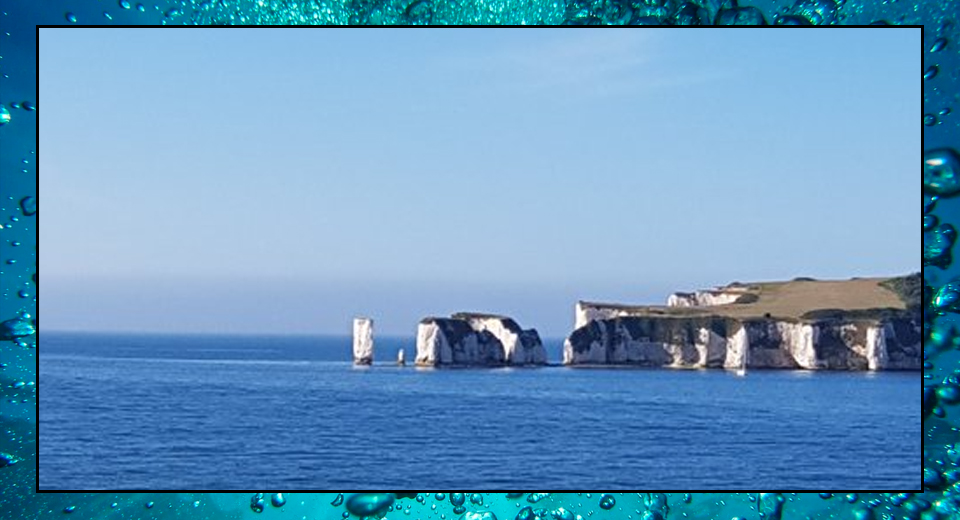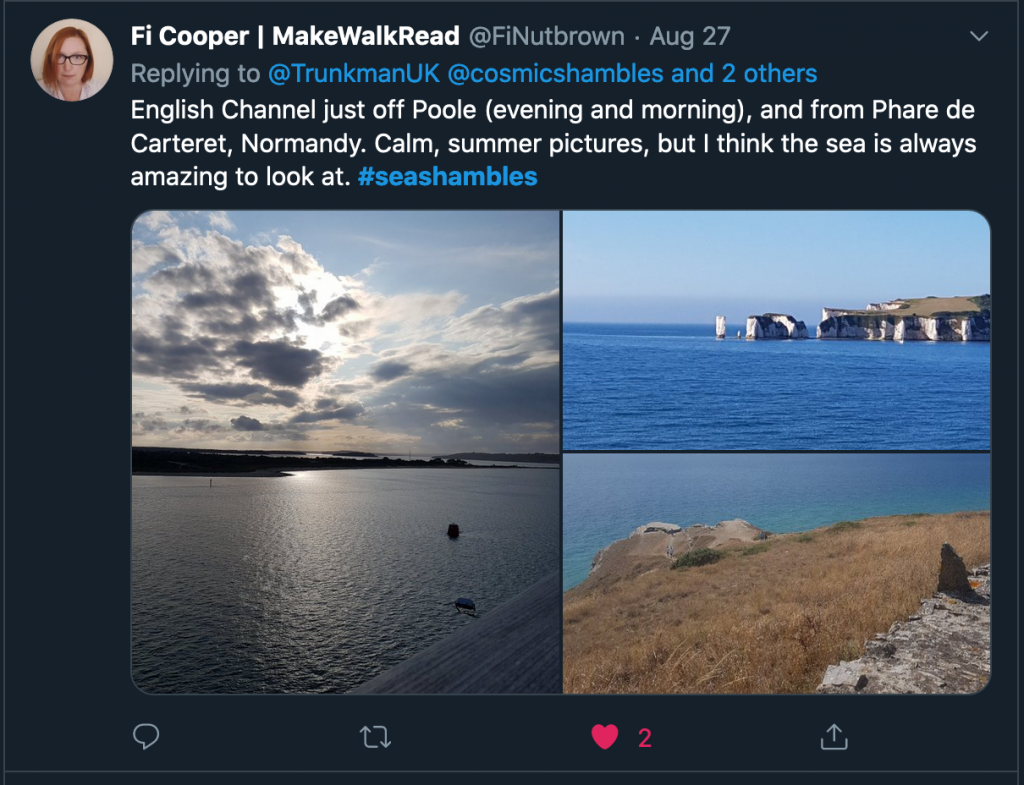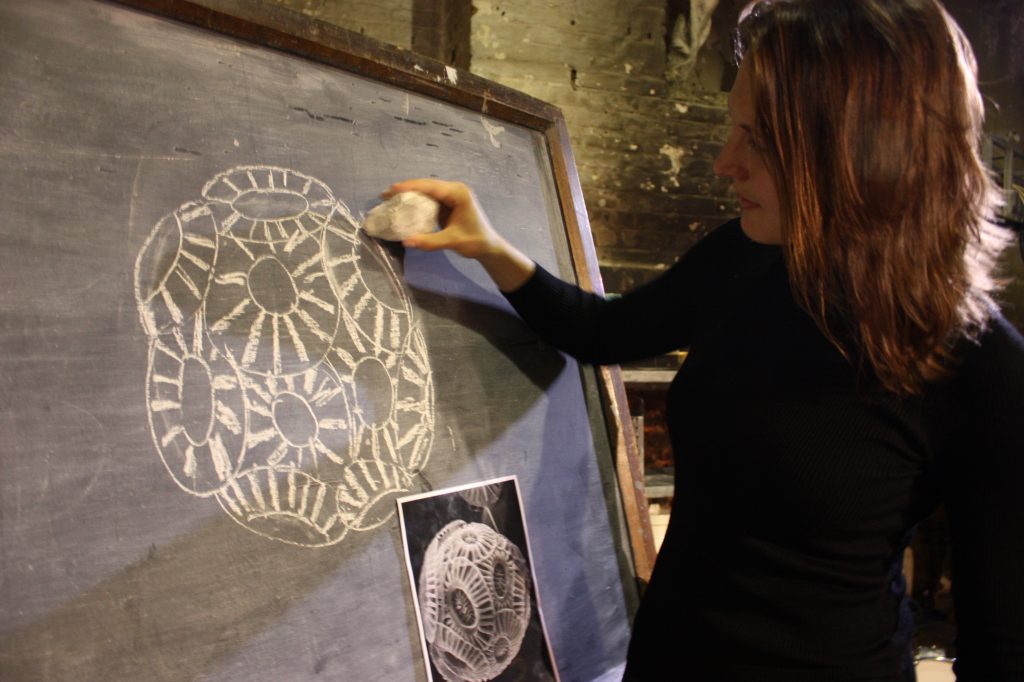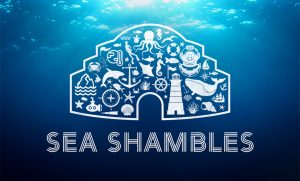Cuttlefish
Sea Shambles Advent Calendar - December 2ndDay Two
I recognise those rocks because my outrigger canoe club has a training camp nearby every year – it’s Old Harry Rocks in Studland Bay.

This picture was sent in by @FiNutBrown on Twitter, and it was taken near Poole. It’s a beautiful and dramatic rock formation, and this picture was taken on a stunning day. I picked it today because of what the rock stacks are made from: chalk. Every time I see a cliff like that, I’m reminded of how good the ocean is at recycling, and of the potential for each atom as it goes round and round the cycle.
80 million years ago, what is now the south coast of Britain was a sea. But it was also a forest, or at least the ocean version of a forest for at least some of the time. We know that plants capture the sun’s energy and use it to build sugars – that’s photosynthesis – but when we think of that process, we usually think about trees and flowers. Those are only half the story. A tree is large, stationary and old. But in the ocean, that same job is done by fragile floating algae that are so small they’re just a single cell. They’re miniscule factories, constructing themselves out of nutrients in the water around them, fuelled by sunlight. They’re tiny, mobile, and short-lived, but when conditions are right they can grow in utterly gigantic numbers. This is what a forest looks like in the ocean: a greenish underwater mist that stretches for miles.

Today, we can see large blooms of these cells from space. But 80 million years ago, they were living and dying unobserved. The ones over the south coast of Britain were coccolithophores, each with a dramatic armour of platelets made from calcium-based minerals. These platelets are astonishing, intricate works of art assembled inside the cell and then pushed outwards to reinforce the outer shield. The creatures that grazed on them didn’t care, hoovering them up and keeping things in check. But when a forest grew too quickly, the coccolithophores lived and died and lived and died, and when they died they sank down to the seafloor to accumulate in a giant seafloor cemetery. Eons passed, and the crushing pressure turned algae into rock, and the rocks moved until they eventually came to be called the south coast of Britain. This is chalk: the leftovers of thousands of fits of biological enthusiasm, hauled up into the sunlight to be inspected by bipeds with hammers and notebooks.
The Cosmic Shambles Network relies on your support on pledges via Patreon so we can continue to provide great, new, exciting content without the need for third party ads or paywalls.
For as little as $1 a month you can support what we do and get some great rewards for doing so as well. Click the Patreon logo to pledge or find out more.
But it didn’t end there. Chalk is white and crumbly, and if you scrape it across painted wood, it leaves a white mark. I love the thought that for centuries, history and maths and languages and science were passed on from human to human via marks made with ancient crushed sea creatures. Once the chalk dust finds its way back into the sea, the cycle will begin again. Modern chalk isn’t made this way, which is both a good thing and a bit of a shame.
A few years ago, I borrowed a piece of chalk from the Royal Institution, and I drew a coccolithophore with itself. This made me extremely happy. You can see a picture of that below.

Me drawing a coccolithophore with itself, using chalk from the White Cliffs of Dover. Pic by the RI
 Sea Shambles is a one night only live extravaganza celebrating the oceans. Hosted by Robin Ince and Helen Czerski with Steve Backshall, British Sea Power, Josie Long, Lemn Sissay and more it’s a night of science, comedy, music, lasers and more in which we’ll be turning the Royal Albert Hall into an underwater playground the likes of which you’ve never seen! May 17 2020. Tickets start at just £10! Book here.
Sea Shambles is a one night only live extravaganza celebrating the oceans. Hosted by Robin Ince and Helen Czerski with Steve Backshall, British Sea Power, Josie Long, Lemn Sissay and more it’s a night of science, comedy, music, lasers and more in which we’ll be turning the Royal Albert Hall into an underwater playground the likes of which you’ve never seen! May 17 2020. Tickets start at just £10! Book here.
 Dr Helen Czerski is a physicist, first and foremost, but she’s acquired a few other labels along the way: oceanographer, presenter, author and bubble enthusiast. A regular on The Cosmic Shambles Network, she has also presented a number of acclaimed documentaries for the BBC and Fully Charged. Recently she was awarded the prestigious William Thomson, Lord Kelvin Medal and Prize from the Institute of Physics.
Dr Helen Czerski is a physicist, first and foremost, but she’s acquired a few other labels along the way: oceanographer, presenter, author and bubble enthusiast. A regular on The Cosmic Shambles Network, she has also presented a number of acclaimed documentaries for the BBC and Fully Charged. Recently she was awarded the prestigious William Thomson, Lord Kelvin Medal and Prize from the Institute of Physics.
If you would like to reuse this content please contact us for details
Subscribe to The Cosmic Shambles Network Mailing list here.
The Cosmic Shambles Network relies on your support on pledges via Patreon so we can continue to provide great, new, exciting content without the need for third party ads or paywalls.
For as little as $1 a month you can support what we do and get some great rewards for doing so as well. Click the Patreon logo to pledge or find out more.

